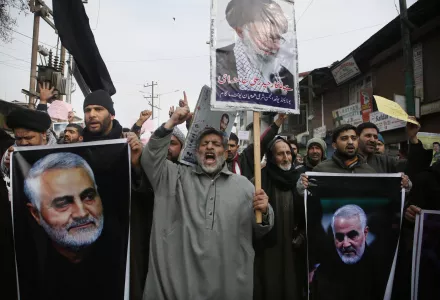
The U.S. killing of Qassem Soleimani, the head of Iran’s Islamic Revolutionary Guards Corps’ Quds Force, has dramatically intensified U.S.-Iranian tensions. To help shed light on the factors that make this airstrike so potentially consequential, the Belfer Center has curated select past articles from our archive. Click here to view thoughts and insights on the impacts of the action from Belfer Center experts.
June 2019
The Dangers of Trump’s Approach to Iran
In this interview with The New Yorker, former U.S. Ambassador Wendy Sherman—a key architect of the U.S.-Iran nuclear deal—reflects on the Trump administration’s strategy toward Iran.
“…what we are experiencing right now is an escalatory cycle between the hard-hard-liners in each of our countries. They are spinning each other up on a path that could lead us to a war that is unnecessary, in my view, and will be horribly destructive.”
January 2014
Iran’s Fingerprints in Fallujah
This column by David Ignatius in The Washington Post examines how Soleimani masterminded Iranian influence in Iraq.
“The Iranians, it must be said, play the Iraqi game with a finesse and staying power the United States has never matched.”
March 2017 (PDF)
Deterring Iran After the Nuclear Deal
This report chapter from former Cyber Project Director Michael Sulmeyer assesses Iran’s capabilities in cyberspace.
“The United States and its partners should be postured to respond promptly and proportionally to aggressive Iranian cyber operations. The more time that elapses between an unacceptable cyberattack and a Western response, the harder it is to signal credibly that cost will be, and will continue to be, imposed.”
April 2015
The ‘Smiling Minister’ and the Quds Commander: The Two Faces of Iran
This article from former Belfer Center Research Fellow Ariane Tabatabai explains why Soleimani enjoyed such popular support in Iran.
“Soleimani, on the other hand, has become popular despite the Guards’ general bad reputation and unpopularity among Iranians. After all, the Guards are seen as the perpetrators of human rights violations in the country and their name is associated with crackdowns on those with divergent views. But Soleimani and his team stepped in and capitalized on a bigger fear in Iran: the threat of a foreign attack.”
April 2019
The U.S. Names the Iranian Revolutionary Guard a Terrorist Organization and Sanctions the International Criminal Court
Former Belfer Center Research Fellow Elena Chachko explains why the Trump administration—in an unprecedented step—designated an entire component of a foreign government as a “foreign terrorist organization.”
“Both the IRGC designation and the ICC individual sanctions are instances of the heavy U.S. reliance on targeted sanctions as a foreign and security policy tool.”
